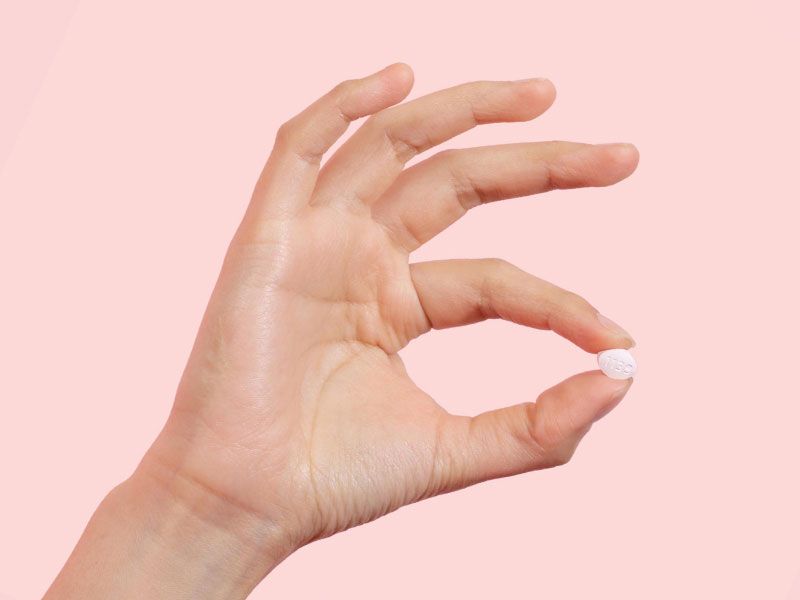
When To Take A Second
Fluconazole For Yeast Infection
Published on October 6, 2021
Updated on October 22, 2025
Written by Kathleen Morrison
Medically Reviewed by Andrea Sleeth WHNP-BC, MSCP
Key takeaways
- Most yeast infections clear with one 150 mg dose of fluconazole, with a second dose if symptoms stick around.
- Support your body with hydration, nutrient-rich foods, and probiotics to help your vaginal flora thrive.
- Chronic or recurring yeast infections might need personalized guidance from a healthcare provider.
- Keep track of your symptoms to help your provider tailor treatment and spot patterns early.
Yeast infections are frustrating, irritating, and uncomfortable. If you’ve had one before, you’ll always recognize the symptoms, and you’ll want to find relief fast. There are lots of over-the-counter solutions you can find at the drugstore, but the most frequently prescribed yeast infection medication is fluconazole, a "1-pill" yeast infection cure.
Fluconazole (also known as Diflucan) is a strong prescription antifungal, trusted by doctors, that tackles yeast infections from the inside out. Even though it’s highly effective, yeast infections can be very stubborn, so providers will often prescribe 2 doses of this medication just in case the first one doesn’t quite knock out your symptoms.
Wisp treatment options are available only after consultation with a licensed medical professional. You should consult with your healthcare provider before starting a new supplement or treatment regimen. Individual results may vary.
How long does fluconazole take to work?
First, it helps to know what to expect after your first dose. Timing can vary depending on the severity of your infection and your body’s response, but here’s a typical timeline:
What happens after you take fluconazole?
- First 24 hours: You may start noticing a slight reduction in itchiness, irritation, or burning. Discomfort might still be present, but should begin to ease.
- 1–3 days: Symptoms like itching, redness, and unusual discharge usually start improving noticeably. If things aren’t getting better, your provider may suggest taking the second dose if you haven’t already.
- 3–5 days: Most of the discomfort should be gone, and your vaginal area should feel much more normal.
- Around a week: The infection is usually fully cleared for most people, though some minor irritation may linger. Contact your provider if symptoms persist beyond a week.
This is a pretty realistic picture of what to expect, so you know when to follow up or take the next step in your treatment.
When should I take second fluconazole 150 mg?
Once you’re sure you have a yeast infection and decide to get prescription fluconazole treatment, your provider will likely prescribe two 150 mg tablets.
If your symptoms don’t improve a day or two after your first dose, take a look at the label on your prescription’s packaging to see when it’s time to take another pill. The second dose simply adds a little more antifungal power to treat a stubborn infection.
If your symptoms do not see any improvement within a week, let your medical provider know, and they may prescribe you a different medication or a more intensive treatment regimen with fluconazole.
What happens after taking a second Fluconazole?
Be patient and allow the medication to take effect. Your body won't heal immediately, but you should notice improvement within a day or two. If you're prone to yeast infections, it may mean your body chemistry takes a bit more time to regain its balance.
Staying clean and dry in cotton undies, sticking with loose-fitting clothes, and making sure you get treatment from a doctor when you have yeast infection symptoms are all great ways to help support your vaginal health and help break a cycle of recurrent infections.
Boric acid and probiotics can be great additions to your yeast infection toolkit. Taking them in addition to your prescription treatment can help support your recovery and keep you feeling better for longer. Integrating them into your routine can also help your vaginal flora thrive and contribute to a healthy microbiome.
How often can you take fluconazole for a yeast infection?
Most people only need one or two doses of fluconazole to clear up a typical yeast infection. If your symptoms come back or you get recurring infections, your provider might discuss a longer-term treatment plan.
- For occasional yeast infections, taking a single 150 mg dose (or a second dose if needed) is usually enough.
- If infections keep coming back, your provider might recommend a weekly or monthly maintenance regimen for a few months.
- Never take more than the prescribed amount on your own, and always check in with your provider if symptoms persist or return.
Your healthcare provider can personalize your plan based on your history, symptoms, and overall health, making sure you get the right dose at the right frequency.
How do I know if I still have a Yeast Infection?
Chronic yeast infection symptoms should be pretty familiar to you if you've experienced even one yeast infection. However, these symptoms often overlap with other common vaginal infections like Bacterial Vaginosis (BV). If you aren’t quite sure what you’re dealing with, you can always take Wisp’s Symptoms Quiz to help you figure out what’s going on. Typically, chronic yeast infection symptoms consist of:
- Itching
- White and chunky discharge
- Odorless discharge, or a very mild yeast infection smell
- Burning when urine touches raw, irritated skin
Why does my Yeast Infection keep coming back?
Many people experience recurrent or chronic yeast infection symptoms that leave them wondering, “Why does my yeast infection keep coming back?” There are a few different possible causes of these repeated symptoms:
- Your initial infection wasn't treated completely
- You're creating humid or moist conditions for Candida to thrive
- You have a drug-resistant strain of yeast
- Your vaginal bacteria is out of whack
- You have a weakened immune system
What's the difference between a Yeast Infection and BV?
A yeast infection can also be confused with BV, but there are key differences when it comes to BV Symptoms, such as:
- Intense “fishy” vaginal odor
- Thin grey or greenish discharge
- Itch
- Burning during urination
If you’re experiencing unusual odor and grey or green discharge, you’re likely dealing with BV. But if you just aren’t sure, it’s always best to who can provide the proper diagnosis and treatment!
What else can you do to support your body when you have a Yeast Infection?
While the medication works on the infection itself, there are other things you can do to support your body and help make recovery feel smoother:
- Focus on nutrients that support your immune system: Iron, zinc, vitamin C, and B vitamins all play a role in keeping your immune defenses strong. Low iron can sometimes make infections linger, but too much iron can feed yeast, so aim for balance.
- Consider probiotics: Supplements or foods with Lactobacillus can help restore your natural vaginal flora and may help your body respond better to treatment.
- Stay hydrated and manage sugar intake: Yeast thrives on sugar, so keeping your blood sugar stable can give the medication a better chance to work.
- Track your symptoms: Note what makes your discomfort better or worse, so your provider can tailor future care if infections recur.
Supporting your body with these small steps alongside your fluconazole dose can help you get back to feeling like yourself faster.
Don’t let yeast crash your party
Yeast infections are a total nuisance, but you don’t have to let them run your life. Knowing when to take a second fluconazole dose and giving your body a little extra TLC can help you bounce back faster. Pair your prescription with supportive steps—like staying hydrated, balancing nutrients, and considering probiotics—and you’ll be back to feeling like yourself in no time.
Whether you’re dealing with a one-off infection, recurring symptoms, or want guidance on hormonal or vaginal health, a Wisp provider can guide you with practical, personalized advice and treatment—right from home.
This blog post is for informational and educational purposes only and should not be taken as professional advice. Always consult with a qualified professional before making any decisions based on the information provided here.






